Asia-Pacific Ultrasound Devices Market Size
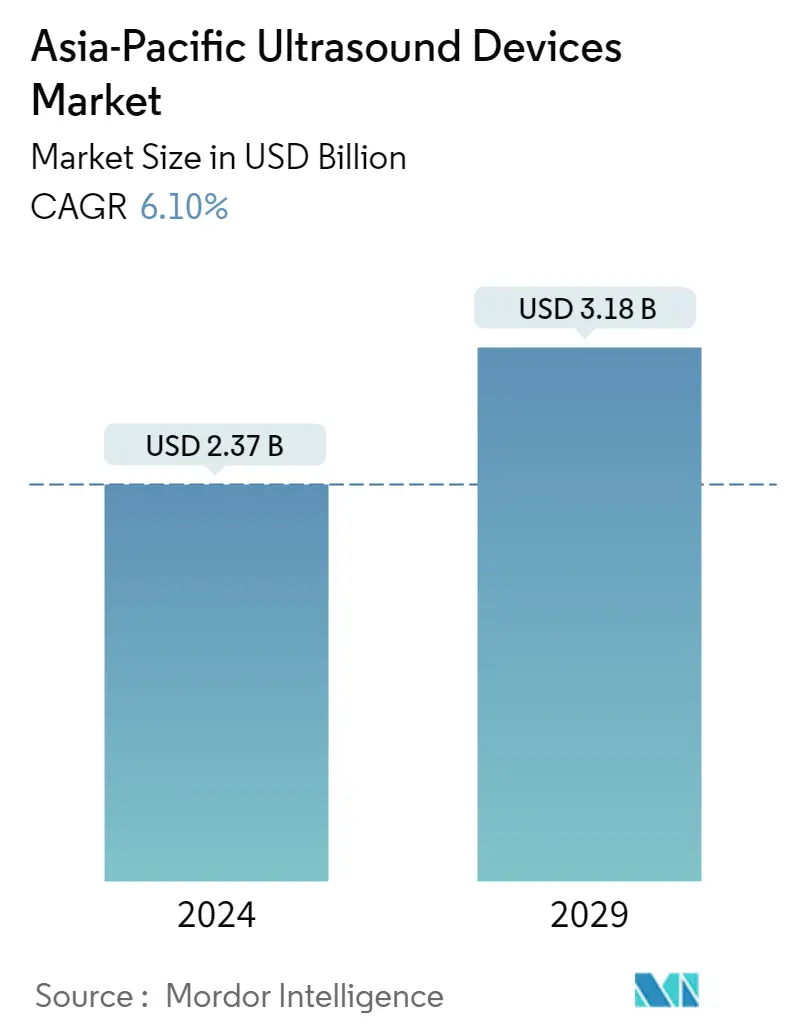
| Study Period | 2019 - 2029 |
| Base Year For Estimation | 2023 |
| Forecast Data Period | 2024 - 2029 |
| Market Size (2024) | USD 2.37 Billion |
| Market Size (2029) | USD 3.18 Billion |
| CAGR (2024 - 2029) | 6.10 % |
Major Players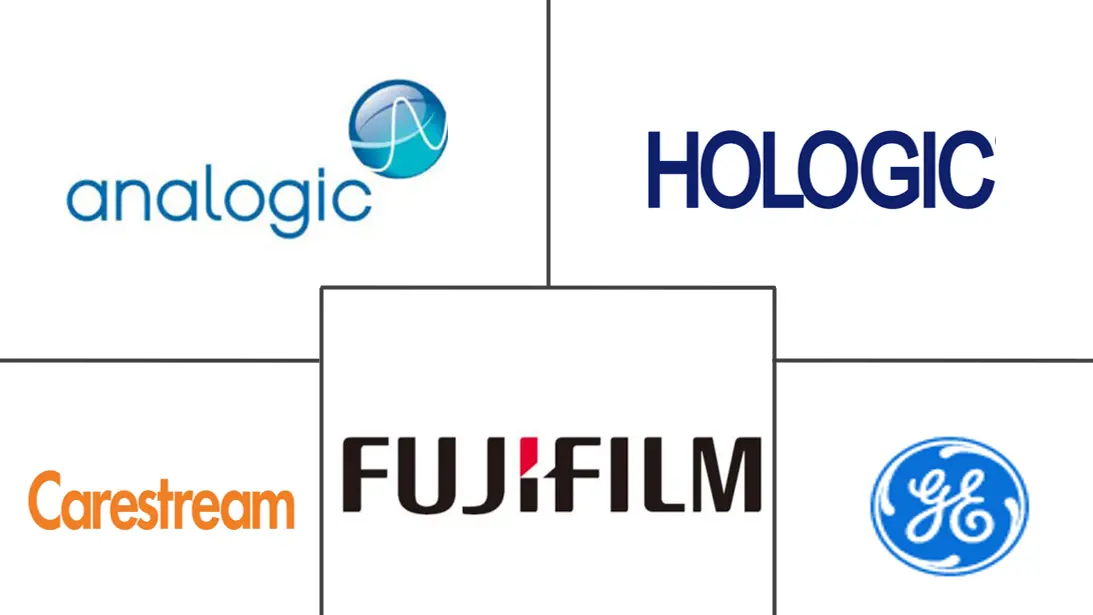
*Disclaimer: Major Players sorted in no particular order |
Asia-Pacific Ultrasound Devices Market Analysis
The Asia-Pacific Ultrasound Devices Market size is estimated at USD 2.37 billion in 2024, and is expected to reach USD 3.18 billion by 2029, growing at a CAGR of 6.10% during the forecast period (2024-2029).
The COVID-19 pandemic has impacted the growth of various sectors including healthcare, biotechnology, pharmaceutical industries, and various markets, including the ultrasound market in the Asia-Pacific region. The ultrasound market has been severely impacted by the pandemic due to the lockdown imposition and high infectivity of the SARS-CoV-2 virus. For instance, an article titled, 'Diagnostic Ultrasound Services During the Coronavirus Disease (COVID-19) Pandemic' published in November 2020 reported that diagnostics were at high risk of contamination and infection transmission as it requires extensive logistical planning for intrahospital patient transport, healthcare provider safety, and post-imaging decontamination. Thus, due to all these reasons, the demand for ultrasound devices got reduced due to the halt in emergency procedures. The unfavorable changes in regulations and guidelines hampered the growth of this market. The closing down of manufacturing facilities due to lockdowns, disruptions in supply chains, and recruitment challenges for clinical trials have further impacted the growth of the overall Asia-Pacific ultrasound market. However, after a few months due to the ease in the government restrictions, the hospital services got to resume the market witnessed significant growth.
The factors that are expected to be driving the Asia-Pacific ultrasound devices market are growing public awareness about the need for diagnosis, increased adoption of diagnostic imaging, an increasingly aging population, and rapid technological advancements. The increasing awareness of getting the disease diagnosed by ultrasound devices is propelling the growth of the studied market in the region. For instance, an article titled, 'Implementation of a large-scale breast cancer early detection program in a resource-constrained setting: real-world experiences from 2 large states in India' published in May 2022 reported that an estimated 178,361 new breast cancer cases were reported in India in 2020. The article reported that many initiatives are launched by the government to increase early breast cancer detection and individuals in the region are getting aware of early detection of breast cancers, which is fueling the growth of the studied market. The increased adoption of diagnostic imaging is another reason for driving this market as minimally invasive therapies and image-guided procedures are increasingly being adopted by healthcare professionals and patients across the Asia-Pacific region. The higher incidence of chronic diseases-such as cancer, stroke, and neurological and cardiovascular diseases-and the higher death rates in these countries, and the increasing awareness among the population for early diagnosis detection. For instance, an article titled, 'Early detection of melanoma in specialized primary care practice in Australia' published in February 2021 reported the public awareness of fast-growing melanoma and the primary care skin cancer clinics to facilitate early treatment of melanoma in Australia. Thus, the increasing prevalence of chronic diseases and the application of ultrasound in the diagnosis and treatment of these diseases is expected to increase the adoption of ultrasound and thus, fueling growth in the studied market.
An increasingly aging population in the region is constantly propelling the need for imaging diagnostics like ultrasound, and the risk of developing diseases increases proportionately with age. For instance, an article titled, 'Prevalence and potential determinants of chronic disease among elderly in India: Rural-urban perspectives' published in March 2022 reported that about 21% o the elderly in India reportedly have at least one chronic disease, 17% of elderly in rural areas and 29% in urban areas suffer from a chronic disease. The article also quoted that the elderly population in India is expected to grow to 158.7 million by 2025, which would be 11.1% of the total population. This increase in the aging population and the high incidence of chronic diseases associated with aging is driving the demand for improved healthcare facilities and advanced treatment options, thereby an increasing need for better diagnostics devices, to get the disease detected at an early stage, thereby propelling the growth of the Asia-Pacific ultrasound devices market. Moreover, the rapid technological advancements in ultrasound diagnosis such as orthopedic medical imaging provide a non-invasive approach to examining the internal structures of a patient to diagnose medical conditions. Also, it is used to offer high-quality imaging to reduce the requirement of surgeries and for decision-making. This medical imaging tool has proved to be an informational tool that has helped physicians to detect the disease and respond to the treatment. Thus, such technological advancements are constantly fueling the market. Thus, due to the aforesaid mentioned reasons, the market is expected to witness significant growth over the forecast period. However, reimbursement concerns and high costs associated with the devices and procedures may hinder the growth of the studied market.
Asia-Pacific Ultrasound Devices Market Trends
This section covers the major market trends shaping the APAC Ultrasound Devices Market according to our research experts:
3D and 4D Ultrasound Imaging Segment is Expected to Witness a Significant Growth Over the Forecast Period.
3D ultrasound imaging has the potential to provide real-time imaging of the anatomical structure. Real-time 3D ultrasound has more advantages for guiding interventional procedures. These devices can visualize real-time tissue organs in 3D, while a 4D ultrasound is like a 3D ultrasound except that the image it generates is continuously updated, much like a moving image. The 3D and 4D ultrasound imaging are expected to witness significant growth over the forecast period, owing to the extensive technological advancements in the development of 3D and 4D ultrasound devices, favorable reimbursements, a wide range of applications, and added advantages of the devices, such as high definition (HD) motion and 3D and 4D visualizations.
New product launches by key market players are also fueling the market in the Asia-Pacific region. For instance, in June 2022, Mindray launched a new ultrasound product to address the unique demands of busy obstetrics and gynecology (OB/GYN) practices, the Imagyn I9 Ultrasound Machine. The Imagyn I9 Ultrasound System is Mindray's first dedicated obstetrics and gynecology (OB/GYN) product slated to meet the rigorous demands of its practices. Also, the use of real-time 3D/4D or echocardiography technology to evaluate a patient's cardiac condition is propelling the growth of this segment due to the high incidence of cardiovascular disease (CVDs) reported in many countries of the Asia-Pacific region. For instance, an article titled, 'Cardiovascular disease (CVD) and its associated risk factors among older adults in India: Evidence from LASI Wave 1' published in February 2022 reported that the overall self-reported prevalence of diagnosed cardiovascular disease prevalence (CVDs) was 29.4% for older adults aged 45 and above in 2020 in India. Thus, due to the aforesaid mentioned reasons, the segment is expected to witness significant growth over the forecast period, thereby fueling the growth of the studied market.
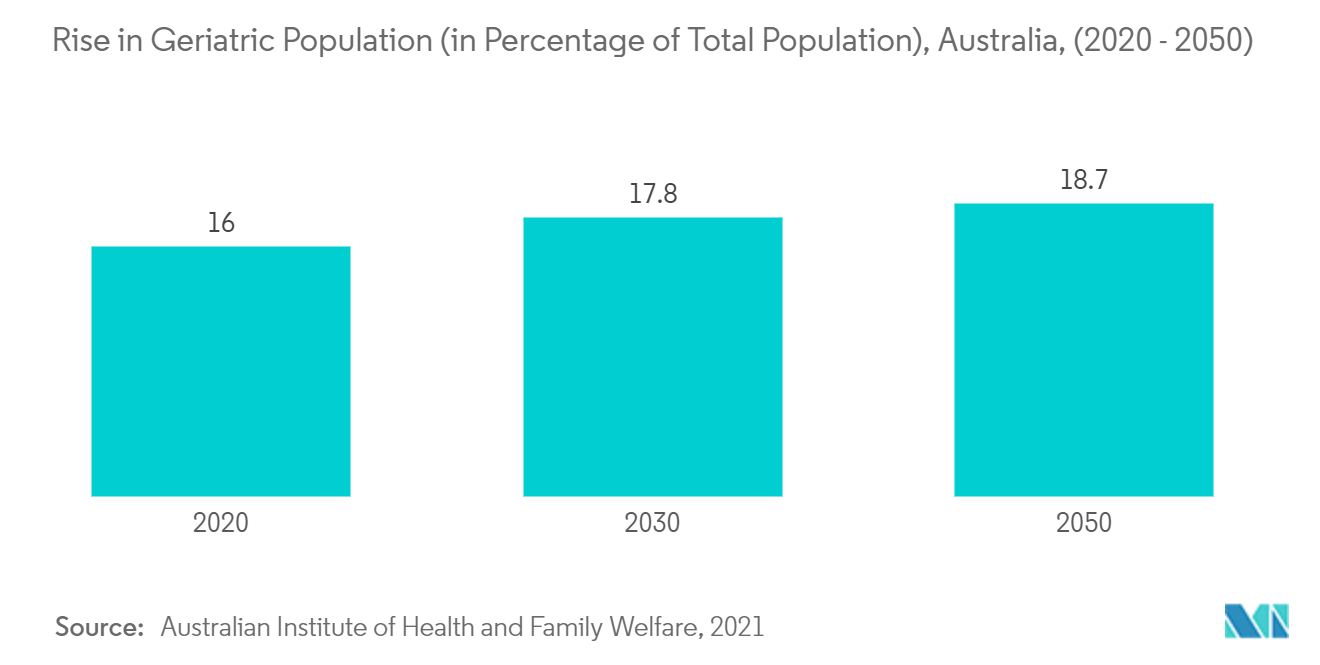
China is Expected to Witness Significant Growth Over the Studied Forecast Period.
China is expected to witness significant growth over the forecast period due to technological advancement, key market players, the increase in the aging population, and the rise in cases of cancer. Ultrasound devices provide clear pictures of some soft tissue diseases and it is a good way to detect fluid-filled cysts from solid tumors because they make very different echo patterns. It's useful in some situations because it can usually be done quickly and doesn't expose people to radiation. Thus, it can also help to detect cancers. The increasing incidence of cancer cases in China is fueling the growth of this market. For instance, the 2021 Globocan database reported 4.57 million cancer cases in the region, and this number is expected to increase up to 6.85 million by 2040, thus fueling the growth of the studied market. Also, the increasing geriatric population in the region is expected to drive the market as they are more susceptible to chronic diseases or more prone to chronic diseases.
Also, various applications and research of ultrasound imaging in the diagnosis of different diseases are fueling the growth of the studied market in China. For instance, an article titled, 'Lung ultrasound completely replaced chest X-ray for diagnosing neonatal lung diseases: a 3-year clinical practice report from a neonatal intensive care unit in China' published in August 2020 reported that lung ultrasound (LUS) has been widely used in the diagnosis and differential diagnosis of neonatal lung diseases (NCDs), but whether it can replace the routine use of chest X-ray (CXR) in neonatal intensive care units (NICUs). Another clinical study, approved by the Ethics Committee of Huoshenshan Hospital, Wuhan, China published in July 2021, in the article, 'Quantitative Analysis and Automated Lung Ultrasound Scoring for Evaluating COVID-19 Pneumonia With Neural Networks' reported that ultrasonography plays an important role in diagnosing and evaluating COVID-19 pneumonia (PN) in this epidemic. The lung ultrasound scores and lung ultrasound (LUS) were used to estimate the excessive lung fluid that is an important clinical manifestation of COVID-19 pneumonia (PN), with high sensitivity and specificity. Thus, due to the aforesaid mentioned reasons the region is expected to show significant growth over the forecast period, thereby driving the market.
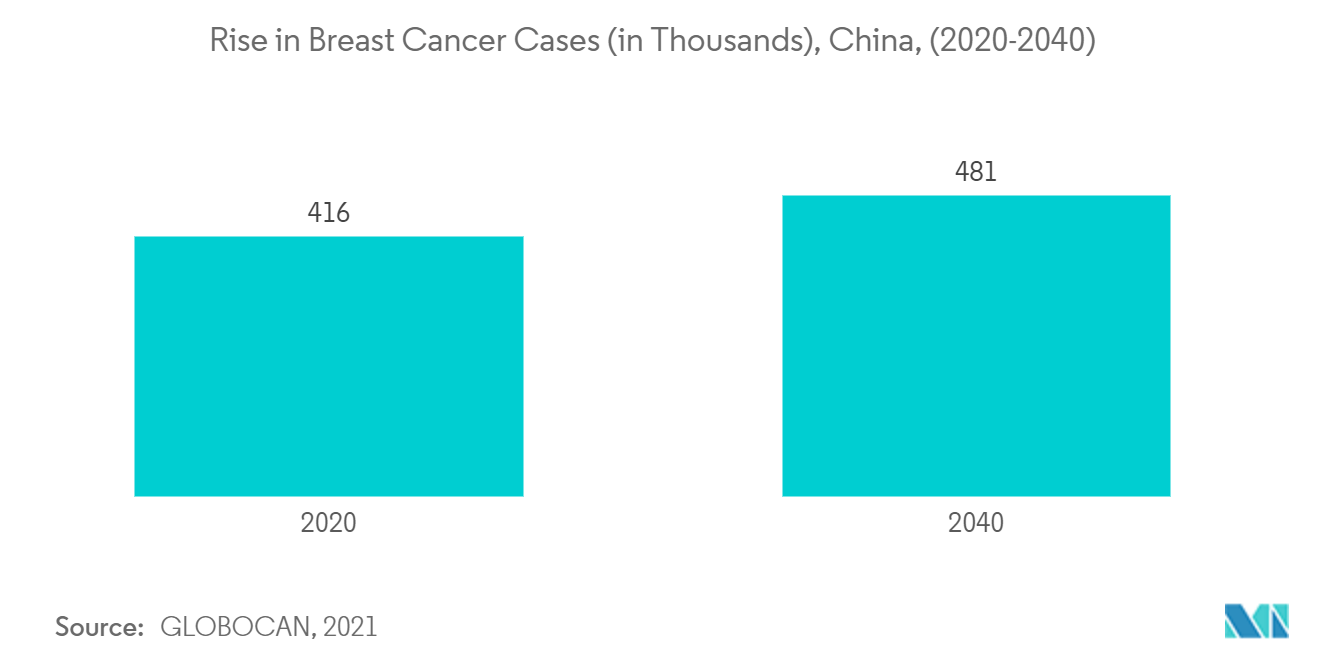
Asia-Pacific Ultrasound Devices Industry Overview
The Asia-Pacific ultrasound devices market is fragmented and competitive in nature due to the presence of companies operating globally as well as regionally. The competitive landscape includes an analysis of a few international as well as local companies which hold the market shares and are well known as Analogic Corporation, Fujifilm Holdings Corporation, GE Healthcare, Chison Medical Technologies Co. Ltd., Koninklijke Philips NV, Mindray Medical International Ltd, Hologic Inc., Samsung Healthcare, Canon Medical Systems Corporation (Toshiba Medical Systems), Wuhan Youkey Bio-Medical Electronics Co., Ltd., Shenzhen Ricso Technology Co., Ltd., and Carestream Health.
Asia-Pacific Ultrasound Devices Market Leaders
-
GE Healthcare
-
Phillips Healthcare
-
Canon Medical Systems Corporation (Toshiba Medical Systems)
-
Fujifilm
-
Carestream
*Disclaimer: Major Players sorted in no particular order
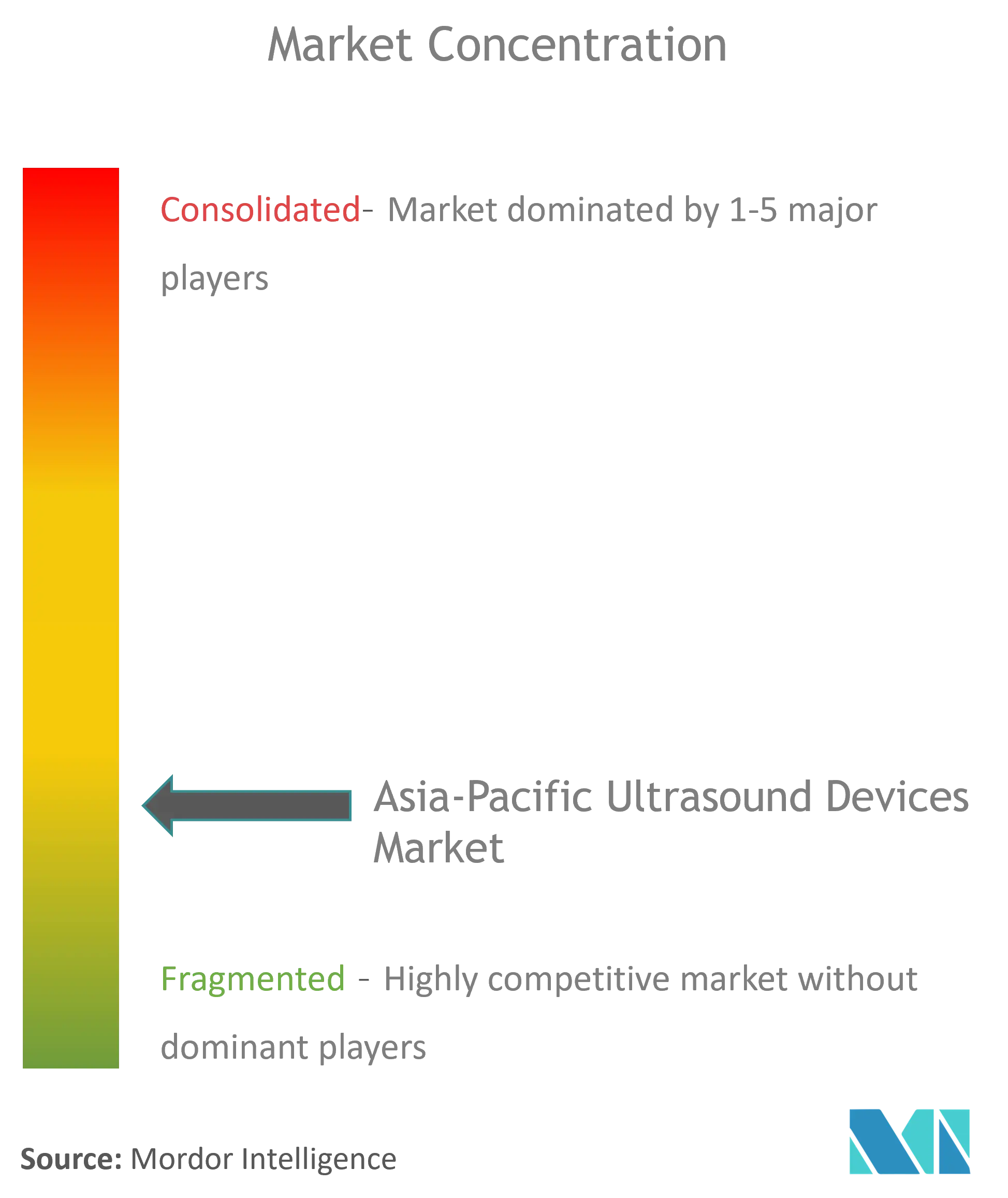
Asia-Pacific Ultrasound Devices Market News
- In March 2022, Fujifilm India unveiled its new range of computed tomography (CT), magnetic resonance imaging (MRI), and ultrasound machines in India.
- In June 2021, Wipro and GE Healthcare started the local manufacturing of its Versana Ultrasound range in India. This is a part of the company's strategy to expand localization and strengthen the supplier ecosystem.
Asia-Pacific Ultrasound Devices Market Report - Table of Contents
1. INTRODUCTION
- 1.1 Study Assumptions and Market Definition
- 1.2 Scope of the Study
2. RESEARCH METHODOLOGY
3. EXECUTIVE SUMMARY
4. MARKET DYNAMICS
- 4.1 Market Overview
-
4.2 Market Drivers
- 4.2.1 Growing Public Awareness about Need for Diagnosis
- 4.2.2 Increasing Adoption of Diagnostic Imaging
- 4.2.3 Increasing Aging Population
- 4.2.4 Rapid Technological Advancements
-
4.3 Market Restraints
- 4.3.1 Reimbursement Concerns
- 4.3.2 High Costs Associated with the Devices and Procedures
-
4.4 Porter's Five Force Analysis
- 4.4.1 Threat of New Entrants
- 4.4.2 Bargaining Power of Buyers/Consumers
- 4.4.3 Bargaining Power of Suppliers
- 4.4.4 Threat of Substitute Products
- 4.4.5 Intensity of Competitive Rivalry
5. MARKET SEGMENTATION (Market Size by Value - USD million)
-
5.1 By Application
- 5.1.1 Anesthesiology
- 5.1.2 Cardiology
- 5.1.3 Gynecology/Obstetrics
- 5.1.4 Musculoskeletal
- 5.1.5 Musculoskeletal
- 5.1.6 Critical Care
- 5.1.7 Other Applications
-
5.2 By Technology
- 5.2.1 2D Ultrasound Imaging
- 5.2.2 3D and 4D Ultrasound Imaging
- 5.2.3 Doppler Imaging
- 5.2.4 High-intensity Focused Ultrasound
-
5.3 By Type
- 5.3.1 Stationary Ultrasound
- 5.3.2 Portable Ultrasound
-
5.4 Geography
- 5.4.1 China
- 5.4.2 Japan
- 5.4.3 India
- 5.4.4 Australia
- 5.4.5 South Korea
- 5.4.6 Rest of Asia-Pacific
6. COMPETITIVE LANDSCAPE
-
6.1 Company Profiles
- 6.1.1 Analogic Corporation
- 6.1.2 Fujifilm Holdings Corporation
- 6.1.3 GE Healthcare
- 6.1.4 Chison Medical Technologies Co., Ltd.
- 6.1.5 Koninklijke Philips NV
- 6.1.6 Mindray Medical International Ltd
- 6.1.7 Hologic Inc.
- 6.1.8 Samsung Healthcare
- 6.1.9 Canon Medical Systems Corporation (Toshiba Medical Systems)
- 6.1.10 Wuhan Youkey Bio-Medical Electronics Co., Ltd.
- 6.1.11 Shenzhen Ricso Technology Co., Ltd.
- 6.1.12 Carestream Health
- *List Not Exhaustive
7. MARKET OPPORTUNITIES AND FUTURE TRENDS
** Subject To AvailablityAsia-Pacific Ultrasound Devices Industry Segmentation
As per the scope of the report, ultrasound, also known as sonography, is an imaging technique that uses high-frequency sound waves to produce images of the different structures inside the body. Ultrasound is being utilized for the assessment of various conditions of the kidney, liver, and other abdominal conditions. It is also majorly used for chronic diseases, which include health conditions, such as heart diseases, asthma, cancer, and diabetes. Thus, ultrasound devices are being utilized as both diagnostic imaging and therapeutic modality, and have a wide range of applications in the medical field. The Asia-Pacific ultrasound devices market is segmented by application (anesthesiology, cardiology, gynecology/obstetrics, musculoskeletal, musculoskeletal, critical care and other applications), technology (2D ultrasound imaging, 3D and 4D ultrasound imaging, doppler imaging, high-intensity focused ultrasound), type (stationary ultrasound, portable ultrasound), geography (China, Japan, India, Australia, South Korea, and Rest of Asia-Pacific). The report offers the value (in USD million) for the above segments.
| By Application | Anesthesiology |
| Cardiology | |
| Gynecology/Obstetrics | |
| Musculoskeletal | |
| Musculoskeletal | |
| Critical Care | |
| Other Applications | |
| By Technology | 2D Ultrasound Imaging |
| 3D and 4D Ultrasound Imaging | |
| Doppler Imaging | |
| High-intensity Focused Ultrasound | |
| By Type | Stationary Ultrasound |
| Portable Ultrasound | |
| Geography | China |
| Japan | |
| India | |
| Australia | |
| South Korea | |
| Rest of Asia-Pacific |
Asia-Pacific Ultrasound Devices Market Research FAQs
How big is the Asia-Pacific Ultrasound Devices Market?
The Asia-Pacific Ultrasound Devices Market size is expected to reach USD 2.37 billion in 2024 and grow at a CAGR of 6.10% to reach USD 3.18 billion by 2029.
What is the current Asia-Pacific Ultrasound Devices Market size?
In 2024, the Asia-Pacific Ultrasound Devices Market size is expected to reach USD 2.37 billion.
Who are the key players in Asia-Pacific Ultrasound Devices Market?
GE Healthcare, Phillips Healthcare, Canon Medical Systems Corporation (Toshiba Medical Systems), Fujifilm and Carestream are the major companies operating in the Asia-Pacific Ultrasound Devices Market.
What years does this Asia-Pacific Ultrasound Devices Market cover, and what was the market size in 2023?
In 2023, the Asia-Pacific Ultrasound Devices Market size was estimated at USD 2.23 billion. The report covers the Asia-Pacific Ultrasound Devices Market historical market size for years: 2019, 2020, 2021, 2022 and 2023. The report also forecasts the Asia-Pacific Ultrasound Devices Market size for years: 2024, 2025, 2026, 2027, 2028 and 2029.
Asia-Pacific Ultrasound Devices Industry Report
Statistics for the 2024 Asia-Pacific Ultrasound Devices market share, size and revenue growth rate, created by Mordor Intelligence™ Industry Reports. Asia-Pacific Ultrasound Devices analysis includes a market forecast outlook to 2029 and historical overview. Get a sample of this industry analysis as a free report PDF download.



